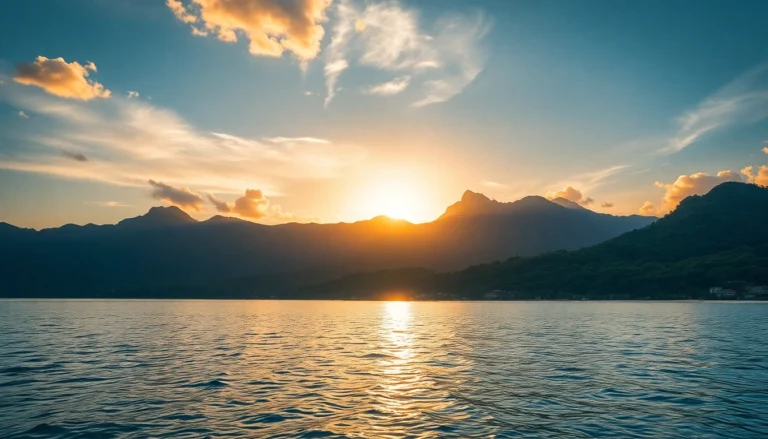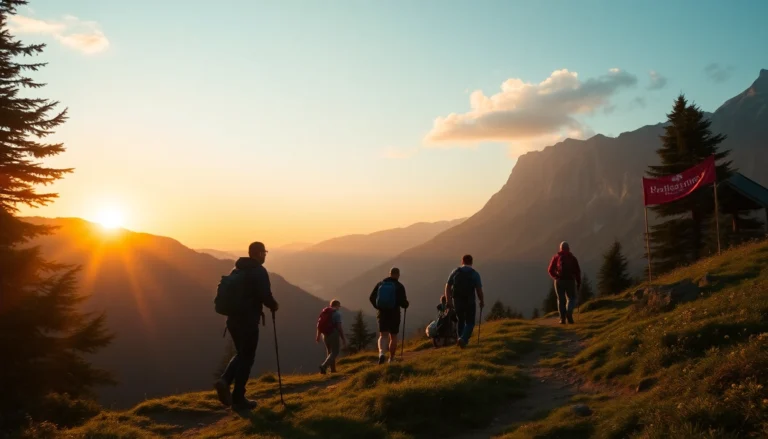
Introduction to Hiking in Indonesia
Indonesia, an archipelago renowned for its breathtaking landscapes and diverse ecosystems, has become a premier destination for outdoor enthusiasts and adventure seekers alike. Among the various outdoor activities, hiking stands out as one of the most accessible and rewarding ways to explore the nation’s natural beauty. From towering volcanoes and lush rainforests to scenic coastlines and hidden waterfalls, Indonesia offers a myriad of trails suited for all levels of hikers. Whether you’re a seasoned trekker or a casual nature lover, understanding the essence of hiking, its benefits, and how to prepare can enhance your experience and ensure safety and enjoyment in every step.
Defining Hiking and Its Appeal in Indonesian Landscapes
Hiking, in its essence, is a vigorous walk along natural trails that often traverse diverse terrains such as mountains, forests, and riverbanks. In Indonesia, hiking carries a special cultural and ecological significance. The country’s rugged topography boasts numerous volcanic mountains like Mount Rinjani, Mount Bromo, and Mount Kerinci, which attract thousands of hikers annually. These mountains not only challenge physical endurance but also offer awe-inspiring views and unique ecosystems.
The appeal of hiking in Indonesia lies beyond physical exercise; it provides a visceral connection with nature, promotes mental clarity, and enriches cultural understanding. For many Indonesians and international visitors, hiking is a means to escape urban congestion and reconnect with serenity, making it an integral part of Indonesia’s outdoor lifestyle.
Popular Hiking Destinations Across Indonesia
Indonesia’s diversity manifests vividly in its hiking destinations, each offering unique experiences:
- Mount Rinjani (Lombok): Indonesia’s second-highest volcano, Rinjani offers an epic multi-day trek with a stunning crater lake, hot springs, and panoramic vistas. It’s ideal for experienced hikers seeking a challenging adventure.
- Mount Bromo (East Java): Renowned for its surreal sunrise views and otherworldly landscape, Bromo’s short yet scenic hike attracts travelers of all skill levels.
- Kerinci Seblat National Park (Sumatra): Home to Mount Kerinci, the highest active volcano in Southeast Asia, this area offers lush rainforests and rich biodiversity, perfect for eco-hikers and wildlife enthusiasts.
- Kelimutu (Flores): Famous for its tri-colored crater lakes, Kelimutu provides a relatively accessible hike with breathtaking scenery.
- Ujung Kulon National Park (Java): A UNESCO World Heritage site, renowned for its pristine wilderness and rare Javan rhinoceroses, offering both cultural and ecological exploration.
Each destination provides an opportunity not only for physical activity but also for cultural immersion, photography, and environmental awareness.
Historical Background and Growing Interest in Outdoor Activities
Historically, Indonesia’s indigenous communities and explorers have engaged in trekking and movement across its varied terrains for centuries. However, modern hiking as a recreational activity surged in Indonesia during the late 20th and early 21st centuries, aligning with global trends emphasizing health, adventure tourism, and environmental consciousness.
The rise of eco-tourism and adventure travel agencies has propelled hiking to the forefront, encouraging responsible tourism and sustainable exploration. Government initiatives and international organizations now promote hiking festivals, conservation campaigns, and community-based tourism projects that include guided treks and trail maintenance.
This burgeoning interest is fueled by increased awareness of outdoor health benefits, a desire to experience Indonesia’s untouched wilderness, and the global popularity of social media-driven travel narratives. As a result, hiking has become more than just a physical activity; it now embodies a cultural movement that fosters environmental stewardship and local economic development.
Preparing for a Hiking Adventure
Essential Gear and Safety Equipment for Hikers
Proper preparation begins with assembling the right gear tailored to the terrain and climate. The fundamental hiking gear includes:
- Footwear: Quality hiking boots or shoes with good grip, ankle support, and waterproof features are essential to prevent injuries and ensure comfort.
- Clothing: Layered clothing suitable for tropical and varying weather conditions—moisture-wicking base layers, insulating mid-layers, and waterproof outer shells.
- Navigation Tools: Topographic maps, compass, or GPS devices to prevent getting lost, especially in remote areas.
- Safety Equipment: First aid kit, multi-tool, flashlight or headlamp, whistle, and personal identification.
- Hydration and Nutrition: Water bottles or hydration packs, water purification tablets, trail snacks, and energy bars.
- Others: Sun protection (hat, sunglasses, sunscreen), insect repellent, and biodegradable waste bags for Leave No Trace compliance.
Additionally, adapting gear to seasonal and specific trail requirements maximizes safety and comfort during your hike.
Planning Routes and Understanding Terrain Challenges
Effective route planning is critical for a safe and enjoyable hike. Start by selecting trails that match your skill level and physical condition. Utilize detailed maps, guidebooks, or local knowledge to understand the terrain, altitude, distance, and potential hazards.
Key planning considerations include:
- Assessing the trail difficulty and elevation gain to match your fitness level.
- Estimating time based on trail length and terrain conditions.
- Identifying water sources, shelter points, and emergency exit routes.
- Considering weather patterns, seasonal variations, and potential trail closures.
It’s advisable to inform someone about your planned route and expected return time, ensuring swift response in case of emergencies.
Physical Preparation and Fitness Tips for Beginners
Hiking demands cardiovascular endurance, muscular strength, and mental resilience. To prepare:
- Start with short, manageable walks to build stamina.
- Incorporate strength training focused on core, legs, and balance.
- Practice hiking with loaded backpacks to simulate trail conditions.
- Engage in aerobic exercises like cycling, swimming, or running.
- Plan regular hikes to gradually increase distance and elevation.
Maintaining a healthy lifestyle, staying hydrated, and practicing proper stretching are vital for injury prevention and sustained performance.
Techniques and Best Practices for Hiking
Leave No Trace Principles to Protect Nature
Responsible hiking emphasizes minimizing environmental impact. The Leave No Trace framework includes:
- Plan ahead and prepare: Know your route and trail conditions.
- Travel and camp on durable surfaces: Stick to established paths and campsites.
- Dispose of waste properly: Pack out all trash and biodegradable waste.
- Leave what you find: Avoid removing plants, rocks, or artifacts.
- Minimize campfire impact: Use stove fuels and avoid building fires in sensitive areas.
- Respect wildlife: Observe animals from a distance without disturbing their habitat.
- Be considerate of other visitors: Keep noise levels down and share the trail respectfully.
Implementing these principles safeguards Indonesia’s pristine environments for future generations.
Managing Hiking Pace and Hydration Strategies
Maintaining a consistent, sustainable pace conserves energy and reduces fatigue. Beginners should start slowly, increasing pace gradually, and taking regular breaks. Listening to your body is critical to prevent overexertion.
Hydration is vital, especially in Indonesia’s humid climate. Sip water regularly, even when not feeling thirsty. Using hydration packs or bottles ensures convenience. Consider adding electrolytes during long hikes to replace lost salts. Nutrition during the hike, including trail snacks and energy gels, helps sustain energy levels.
Proper pacing and hydration strategies promote endurance and enjoyment, enabling hikers to complete their trails feeling refreshed rather than exhausted.
Maximizing Benefits and Overcoming Challenges
Health Benefits of Regular Hiking in Indonesia
Hiking offers numerous physical, mental, and emotional benefits. Physically, it enhances cardiovascular health, muscle strength, flexibility, and balance. Regular hikes can aid in weight management and improve respiratory function, especially in Indonesia’s diverse terrains.
Mental health benefits include stress reduction, improved mood, and increased mindfulness through immersion in nature. The exposure to natural scenery, fresh air, and exercise reduces anxiety and depression often linked to urban lifestyles.
Ecologically, hiking fosters environmental awareness and motivates conservation efforts, contributing to Indonesia’s sustainable tourism initiatives.
Addressing Common Hiking Obstacles and Safety Concerns
Hikers face challenges such as unpredictable weather, difficult terrain, and limited infrastructure in remote areas. Safety concerns include altitude sickness, dehydration, and encounters with wildlife.
Mitigation strategies include:
- Checking weather forecasts and dressing appropriately.
- Carrying sufficient water and nutrition.
- Having basic first aid knowledge and kits ready.
- Hiking with experienced guides or companions in unfamiliar areas.
- Understanding local wildlife behavior and respecting habitat boundaries.
Preparation and awareness significantly reduce risks, allowing hikers to focus on the adventure and discovery.
Sharing Stories and Community Building Among Hikers
Hiking communities foster camaraderie, knowledge exchange, and mutual support. Many Indonesians and visitors participate in hiking clubs, social media groups, and organized events. These communities organize trail cleanups, safety workshops, and cultural exchanges, enriching the hiking experience.
Engaging with fellow hikers builds confidence, enhances safety, and promotes sustainable practices. Sharing stories, photos, and tips through digital platforms encourages more people to embrace outdoor recreation responsibly.
Advanced Tips and Tricks for Enthusiasts
Multi-Day Hiking and Camping Essentials
For avid hikers venturing into multi-day excursions, planning becomes more complex. Essential considerations include:
- Gear: Lightweight tents, sleeping bags suitable for climate, portable stoves, and sufficient food supplies.
- Navigation: Detailed trail maps, GPS devices, and alternative routes in case of emergencies.
- Permits and Regulations: Securing necessary permits from authorities and adhering to conservation guidelines.
- Environmental Impact: Minimizing waste, respecting wildlife, and restoring campsites.
Proper packing, trip logistics, and safety protocols ensure a successful and environmentally friendly adventure.
Wildlife and Plant Identification for Eco-Conscious Hikers
Indonesia’s rich biodiversity offers opportunities for educational exploration. Learning to identify local flora and fauna enhances engagement and ecological understanding. Carrying field guides or using mobile apps can assist in spotting species such as orangutans, hornbills, or endemic orchids.
Responsible observation entails maintaining distance, avoiding habitat disturbance, and respecting protected species’ habitats, aligning with conservation goals.
Using Technology: GPS Apps and Trail Maps Effectively
Modern technology greatly enhances hiking safety and navigation. Reliable smartphone apps with offline capabilities, trail databases, and real-time tracking facilitate route planning and emergency communication. Combining digital tools with traditional navigation methods provides redundancy and confidence in remote environments.
Regular updates, battery management, and familiarity with device features are essential to maximize benefits.



